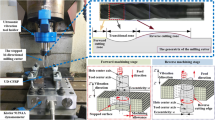Abstract
Conventional drilling is widely adopted to manufacture holes in difficult-to-cut materials such as superalloys. However, as a newer hole processing technology, helical milling possesses several advantages including low cutting forces, reduced tool wear, and improved hole quality. In this study, different hole-making processes like conventional drilling and helical milling were conducted on the superalloy (MSRR7197). Combining the deformation mechanism of the hole wall material, the influence of both hole-making processes on the processing quality of the MSRR7197 were investigated. The experimental results demonstrate that the axial force for the helical milling is about 1/10 of that for the drilling. Compared with drilling, the flank wear, rake wear, and wear of tool tip for the helical milling are smaller. The hole wall quality such as surface morphology and roughness of helical milling is better than that of the drilling. Last but not least, the helical milling can get a higher machining accuracy such as circularity and aperture. Hence, helical milling remains the favorable and alternative to conventional drilling.
Similar content being viewed by others
References
Ulutan D, Ozel T (2011) Machining induced surface integrity in titanium and nickel alloys: a review. Int J Mach Tools Manuf 51(3):250–280
Teti R (2002) Machining of composite materials. CIRP Ann ManufTechnol 51(2):611–634
Sharman AR, Hughes JI, Ridgway K (2004) Workpiece surface integrity and tool life issues when turning Inconel 718 nickel based superalloy. Mach Sci Technol 8(3):399–414
Sridhar BR, Devananda G, Ramachandra K, Bhat R (2003) Effect of machining parameters and heat treatment on the residual stress distribution in titanium alloy IMI-834. J Mater Process Technol 139(1):628–634
Anthony Xavior M, Duchosal A, Jeyapandiarajan P (2018) Experimental investigation on work hardening and residual stress during machining of Inconel 718. Materials Today: Proceedings 5:13301–13308
Sharman ARC, Amarashighe A, Ridgway K (2008) Tool life and surface integrity aspects when drilling and hole making in Inconel 718. J Mater Process Technol 200(1):424–432
Axinte DA, Andrews P (2007) Some considerations on tool wear and workpiece surface quality of holes finished by reaming or milling in a nickel base superalloy. Proc Inst MechEng B J EngManuf 221(4):591–603
Imran M, Mativenga PT, Gholinia A, Withers PJ, 2011 Evaluation of the surface integrity in micro drilling process for nickel based superalloy. Int J AdvManuf Technol 55(5-8):465–476
Kwong J, Axinte DA, Withers PJ, Hardy MC (2009) Minor cutting edge–workpiece interactions in drilling of an advanced nickel-based superalloy. Int J Mach Tool Manu 49:645–658
Baghlani V, Mehbudi P, Akbari J, Nezhad EZ, Sarhan AAD, Hamouda AMS (2016) An optimization technique on ultrasonic and cutting parameters for drilling and deep drilling of nickel-based high-strength Inconel 738LC superalloy with deeper and higher hole quality. Int J AdvManufTechnol 82:877–888
Motorcu AR, Kus A, Durgun I (2014) The evaluation of the effects of control factors on surface roughness in the drilling of Waspaloy superalloy. Measurement 58:394–408
Cuesta M, Aristimuño P, Garay A, Arrazola PJ (2016) Heat transferred to the workpiece based on temperature measurements by IR technique in dry and lubricated drilling of Inconel 718. Appl Therm Eng 104:309–318
Baghlani V, Mehbudi P, Akbari J, Sohrabi M (2013) Ultrasonic assisted deep drilling of Inconel 738LC superalloy. Procedia CIRP 6:571–576
Kong FX, Zhang DY (2012) Micro-lubrication Vibration drilling temperature and tool wear of superalloy. J Beijing Univ Aeronaut Astronaut 38(6):850–852 (in Chinese)
Sharman ARC, Amarasinghe A, Ridgway K (2008) Tool life and surface integrity aspects when drilling and hole making in Inconel 718. J Mater Process Technol 200:424–432
Wang H, Qin X, Li H, Tan Y (2016) A comparative study on helical milling of CFRP/Ti stacks and its individual layers. Int J AdvManufTechnol 86(5–8):1973–1983
Rey PA, LeDref J, Senatore J, Landon Y (2016) Modelling of cutting forces in orbital drilling of titanium alloy Ti-6A-4V. Int J Mach Tool Manu 106:75–88
Wang GD, Kirwa MS, Li N (2018) Experimental studies on a two-step technique to reduce delamination damage during milling of large diameter holes in CFRP/Al stack. Compos Struct 188:330–339
Eguti CCA, Trabasso LG (2014) Design of a robotic orbital driller for assembling aircraft structures. Mechatronics 24:533–545
Dong HY, Chen GL, Zhou L, He FT, Liu ST (2017) Process of composite material/titanium alloy laminated spiral milling. Acta Mater Composit Sin 34(3):541–549
Olvera D, de Lacalle LNL, Urbikain G, Lamikiz A, Rodal P, Zamakona I (2012) Hole making using ball helical milling on titanium alloys. Mach Sci Technol 16:173–188
Pereira RBD, Brandão LC, de Paiva AP, Ferreira JR, Davim JP (2017) A review of helical milling process. Int J Mach Tool Manu 120:27–48
Liu YP, Wang FJ, Jing XB, Zhang DW, Tian XP, Liu YL (2017) Modeling and analyses of helical milling process. Int J AdvManufTechnol 90:1003–1022
Shan Y C (2014) Aeronautical laminated materials helical milling technology basic research. Dissertation, Nanjing University of Aeronautics and Astronautics, China
Liu G, Zhang H, Wang YF, Zhou L, Gao KY, Ke YL, Lu DW (2014) Study on cutting force and machining quality of helical milling CFRP. ActaMateriaeCompositaeSinic 31(5):1292–1299 (in Chinese)
Wang HS (2012) Study on the technology of helical milling for difficult-to-machine materials. In: Dissertation. DalianUniversity of Technology, China
Tian Y, Liu YP, Wang FJ, Jing XB, Zhang DW, Liu XP (2016) Modeling and analyses of helical milling process. Int J AdvManufTechnol 90:1003–1022
Funding
This research is supported by the National Natural Science Foundation of China (Grant No.51875367) (young scientist fund) (Grant No. 51505302), Aeronautical Science Foundation of China (Grant No. 2015ZE54027), and Natural Science Foundation of Liaoning (Grant No. 20170540697).
Author information
Authors and Affiliations
Corresponding author
Rights and permissions
About this article
Cite this article
Wang, B., Chang, K., Wang, M. et al. Experimental studies on helical milling process to improve hole quality for the Superalloy (MSRR7197). Int J Adv Manuf Technol 99, 1449–1458 (2018). https://doi.org/10.1007/s00170-018-2588-3
Received:
Accepted:
Published:
Issue Date:
DOI: https://doi.org/10.1007/s00170-018-2588-3



